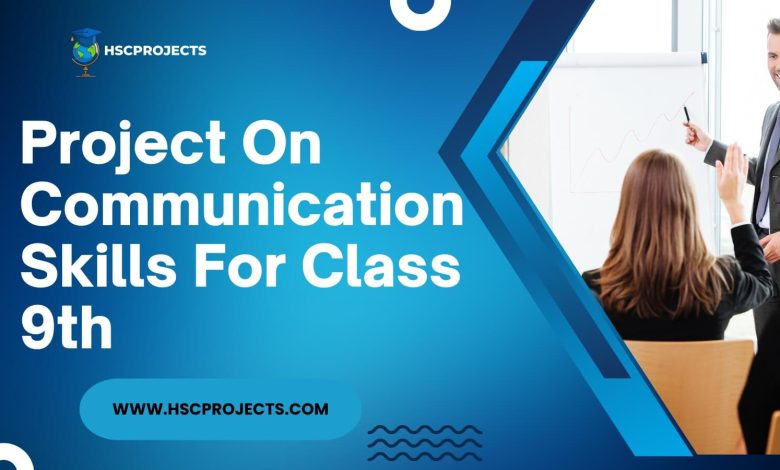
Project On Communication Skills For Class 9th
Acknowledgement
I would like to express my sincere gratitude and appreciation to all those who have supported me throughout the process of completing this project on communication skills. Their guidance, encouragement, and invaluable input have played a significant role in shaping this work.
First and foremost, I would like to extend my heartfelt thanks to my teacher for providing me with this opportunity to explore and delve into the realm of communication skills. Your guidance and expertise have been instrumental in helping me understand the importance of effective communication in our daily lives.
I would also like to express my deep appreciation to my parents for their unwavering support and encouragement. Their constant belief in my abilities and their motivation to excel have been my driving force. Their insightful discussions and suggestions have significantly enhanced the quality of this project.
Additionally, I am grateful to my classmates and friends for their constructive feedback and engaging discussions on the topic. Their perspectives and experiences have broadened my understanding of communication skills and enriched the content of this project.
I would like to acknowledge the contributions of various authors, researchers, and experts whose insightful publications and studies have served as valuable resources for this project. Their dedication to the field of communication and their commitment to sharing knowledge have been instrumental in shaping my understanding of this subject.
Last but not least, I would like to extend my appreciation to all the participants who willingly shared their personal experiences and insights during the research phase. Their willingness to contribute has provided me with real-life examples and practical applications of effective communication skills.
In conclusion, I would like to once again express my heartfelt gratitude to all those who have contributed directly or indirectly to the completion of this project on communication skills. Their support and guidance have been invaluable, and I am truly grateful for their presence in my journey of exploring and understanding effective communication.
Introduction
Effective communication is an essential skill that plays a vital role in our personal, academic, and professional lives. It is the process of conveying information, thoughts, ideas, and emotions to others in a clear, concise, and understandable manner. Communication is not limited to verbal interactions; it also encompasses non-verbal cues, such as body language, facial expressions, and tone of voice.
In today’s fast-paced and interconnected world, the ability to communicate effectively has become increasingly important. It enables us to express ourselves, establish meaningful connections, and build strong relationships with others. Whether it is expressing our thoughts and opinions, collaborating with peers, or presenting our ideas in front of an audience, effective communication empowers us to convey our messages with clarity, confidence, and impact.
Communication skills encompass various aspects, including listening, speaking, reading, writing, and interpersonal skills. Listening skills involve actively paying attention to others, understanding their perspectives, and responding appropriately. Speaking skills involve articulating our thoughts and ideas clearly, using appropriate language and tone for different situations. Reading and writing skills are crucial for comprehending information, expressing ourselves in written form, and conveying messages effectively.
Furthermore, interpersonal skills play a significant role in communication. These skills involve understanding and managing emotions, showing empathy, resolving conflicts, and building rapport with others. Effective communication is not just about what we say, but also about how we listen, understand, and respond to others.
Developing strong communication skills can have numerous benefits. It can enhance our academic performance, as it enables us to effectively participate in classroom discussions, express ourselves in exams and assignments, and collaborate with classmates on group projects. In our personal lives, effective communication helps us establish and maintain healthy relationships, resolve conflicts, and express our needs and desires.
In the professional realm, communication skills are highly sought after by employers. They are crucial for job interviews, networking, presenting ideas, collaborating with colleagues, and delivering persuasive presentations. Strong communication skills can contribute to career advancement, leadership development, and overall success in the workplace.
Tone and Intonation: The tone of voice and intonation add meaning and emotions to our words. They can convey enthusiasm, confidence, empathy, or other sentiments, influencing how the message is receive

Verbal Communication
Verbal communication is one of the primary forms of human interaction, involving the use of spoken or written words to convey messages, ideas, and information. It is a fundamental aspect of effective communication and plays a significant role in various aspects of our lives, including personal relationships, education, and professional endeavors.
Importance of Verbal Communication:
Verbal communication is essential for expressing our thoughts, feelings, and opinions to others. It allows us to share information, engage in meaningful conversations, and build connections with individuals around us. Clear and effective verbal communication is crucial for ensuring that our messages are understood correctly and avoiding misunderstandings or misinterpretations.
- Elements of Verbal Communication: Vocabulary and Language: The choice of words and the language we use impact how our message is perceived. Using appropriate vocabulary and language that is understandable to the audience is important for effective communication. Clarity and Conciseness: Clearly articulating our thoughts and ideas in a concise manner helps ensure that the message is easily understood. Avoiding jargon, complex language, or unnecessary details can enhance clarity.
- Developing Effective Verbal Communication Skills: Active Listening: Active listening is a vital component of effective verbal communication. It involves giving full attention to the speaker, understanding their message, and responding appropriately. Asking questions, paraphrasing, and providing feedback demonstrate active listening.
- Speaking Clearly and Confidently: Practicing clarity in speech by enunciating words, maintaining an appropriate pace, and using a confident tone helps convey messages effectively. Public speaking or joining debate clubs can aid in developing confident verbal communication skills.
- Adapting to the Audience: Adapting our communication style and language to suit the audience enhances understanding and engagement. Consider the background, knowledge level, and cultural context of the listeners to tailor the message effectively.
- Non-Verbal Communication: Non-verbal cues, such as facial expressions, gestures, and body language, accompany verbal communication. Being aware of and using appropriate non-verbal cues can reinforce the spoken message and improve overall communication effectiveness.
- Overcoming Barriers in Verbal Communication:
- Language Barriers: Language differences can hinder effective communication, especially in multicultural or multilingual settings. Efforts such as using simple language, providing translations, or learning common phrases of other languages can help bridge the gap.
- Listening Barriers: Distractions, personal biases, or preconceived notions can hinder active listening. Developing mindfulness and being present in conversations can help overcome these barriers.
- Emotional Barriers: Strong emotions, such as anger, fear, or stress, can affect verbal communication. Managing emotions and practicing emotional intelligence can enable effective communication even in challenging situations.
In conclusion, verbal communication is a crucial skill that enables us to express ourselves, share ideas, and connect with others. By understanding the importance of verbal communication, developing effective skills, and overcoming barriers, we can enhance our ability to communicate clearly, build stronger relationships, and achieve greater success in various aspects of our lives.
Non-Verbal Communication
on-verbal communication refers to the transmission of messages and cues without the use of spoken or written words. It encompasses various aspects, including body language, facial expressions, gestures, eye contact, posture, and even the use of space. Non-verbal communication often complements and enhances verbal communication, playing a crucial role in conveying meaning, emotions, and intentions.
Importance of Non-Verbal Communication:
Non-verbal cues can often carry more weight and convey more meaning than verbal communication alone. They provide additional layers of information, including emotions, attitudes, and sincerity. Understanding and effectively utilizing non-verbal communication can significantly improve the clarity and impact of our messages.
Types and Examples of Non-Verbal Communication:
- Body Language: Our body movements, posture, and gestures can convey a range of messages. For example, crossed arms may indicate defensiveness or resistance, while open and relaxed posture may signify approachability and receptiveness.
- Facial Expressions: Our facial expressions, such as smiles, frowns, raised eyebrows, or narrowed eyes, can communicate various emotions and attitudes. Facial expressions are often universal across cultures, making them an important aspect of non-verbal communication.
- Eye Contact: Eye contact plays a crucial role in non-verbal communication. It can indicate interest, attention, honesty, or confidence. Maintaining appropriate eye contact shows respect and engagement, while avoiding eye contact may convey shyness, discomfort, or lack of confidence.
- Gestures: Hand gestures, such as pointing, waving, or thumbs-up, can add meaning and emphasis to verbal communication. Different cultures may have unique interpretations of certain gestures, so it’s important to be mindful of cultural differences.
- Proxemics: Proxemics refers to the use of personal space and physical distance during communication. Different cultures have varying norms regarding personal space, and understanding these norms helps avoid discomfort or misunderstandings.
- Paralinguistics: Paralinguistic cues include vocal elements such as tone of voice, pitch, volume, and speech rate. These cues can convey emotions, emphasis, or sarcasm, and significantly impact the message being communicated.
- Interpreting Non-Verbal Communication:
- Self-awareness: Developing self-awareness helps us understand our own non-verbal cues and the messages we may inadvertently convey. Reflecting on our body language, facial expressions, and gestures can aid in aligning our non-verbal cues with our intended message.
Interpreting non-verbal cues requires attentiveness, observation, and contextual understanding. It’s important to consider clusters of non-verbal signals rather than relying solely on individual cues. For instance, a smile accompanied by relaxed posture and direct eye contact may indicate genuine friendliness, while a smile with crossed arms and minimal eye contact might suggest skepticism.
- Enhancing Non-Verbal Communication Skills: Observation and Empathy: Paying attention to others’ non-verbal cues and being empathetic can enhance our understanding of their emotions and perspectives. This allows us to respond appropriately and adjust our own communication accordingly.
- Practicing Non-Verbal Cues: Engaging in activities such as role-playing, public speaking, or presentations can help improve our non-verbal communication skills. By consciously practicing body language, facial expressions, and gestures, we can become more confident and effective communicators.
- Cultural Sensitivity: Being mindful of cultural differences in non-verbal communication is crucial, as gestures and body language may have different meanings across cultures. Learning about different cultural norms and adapting our non-verbal cues accordingly can help avoid misunderstandings.
In conclusion, non-verbal communication is a powerful tool for conveying messages, emotions, and intentions. By understanding and effectively utilizing non-verbal cues, we can enhance our communication skills, establish better connections with others, and improve the overall clarity and impact of our communication.
Enhance your creative writing skills
Written Communication
Written communication is the use of written words, symbols, or visual aids to convey information, ideas, or messages. It is a vital form of communication that is widely used in various contexts, including academic, professional, and personal settings. Developing strong written communication skills is essential for effective and impactful communication.
Importance of Written Communication:
Written communication provides a permanent record of information and allows for detailed and precise expression of thoughts and ideas. It is particularly useful when communicating complex or technical information that requires clarity and accuracy. Written communication also enables effective communication across time and distance, as written messages can be stored, shared, and referenced at a later time.
- Developing Effective Written Communication Skills:
- Practice and Feedback: Regular writing practice, such as journaling, essay writing, or professional emails, helps improve written communication skills. Seeking feedback from peers, teachers, or colleagues can provide valuable insights for further improvement.
- Effective Formats of Written Communication:
- Emails: Email communication is prevalent in professional and personal settings. Composing clear and concise emails, using appropriate subject lines, and structuring the content effectively are important for conveying messages efficiently.
- Reports and Essays: Writing reports or essays requires organization, research, and analysis. Presenting information logically, supporting arguments with evidence, and using appropriate citations contribute to effective written communication in these formats.
- Letters and Memos: Formal letters and memos follow specific formats and conventions. Understanding the purpose and audience, and adhering to proper formatting and etiquette, ensures professionalism and clarity in these written forms.
- Presentations and Proposals: Creating visually appealing and engaging presentations or proposals involves combining written content with visual aids. Using persuasive language, clear headings, and bullet points aids in effective communication in these formats.
In conclusion, written communication is a crucial skill for conveying information, ideas, and messages accurately and effectively. By developing strong written communication skills, individuals can communicate with clarity, professionalism, and impact across various contexts, contributing to their academic, professional, and personal success.
Active Listening is a must have skill
Listening Skills
Listening skills refer to the ability to receive, interpret, and understand spoken information effectively. It is an essential component of effective communication and plays a significant role in various aspects of our lives, including personal relationships, academic pursuits, and professional interactions. Developing strong listening skills can lead to better understanding, improved relationships, and enhanced problem-solving abilities.
Importance of Listening Skills:
Listening is more than just hearing words; it involves actively engaging with the speaker, comprehending their message, and demonstrating empathy and respect. Effective listening skills are crucial for building trust, resolving conflicts, fostering collaboration, and gaining valuable insights from others. It is a key component of successful communication.
- Active Listening Techniques: Paying Attention: Giving undivided attention to the speaker demonstrates respect and shows that their message is valued. Minimizing distractions, maintaining eye contact, and focusing on the speaker’s words and non-verbal cues are essential for active listening.
- Clarifying and Paraphrasing: Seeking clarification by asking questions or restating key points in your own words ensures understanding and shows genuine interest in the speaker’s message. Paraphrasing also helps to confirm comprehension and allows the speaker to clarify any misunderstandings.
- Empathizing and Showing Interest: Demonstrating empathy and interest in the speaker’s perspective and emotions encourages open and honest communication. Non-verbal cues such as nodding, smiling, or using appropriate facial expressions convey attentiveness and support.
- Avoiding Interruptions and Judgments: Allowing the speaker to express their thoughts without interruption or premature judgment fosters a safe and open communication environment. Avoiding the urge to interrupt, providing space for the speaker to finish their sentences, and reserving judgment until the entire message is conveyed are key aspects of active listening.
Conclusion
Effective communication is a vital skill that influences every aspect of our lives. Whether it’s verbal, non-verbal, written, or listening communication, each facet plays a crucial role in conveying our thoughts, ideas, and emotions to others. Developing and honing our communication skills can lead to stronger relationships, improved academic performance, and increased success in our professional endeavors.
Throughout this project, we have explored the various components of communication skills. We acknowledged the importance of effective communication and its impact on personal, academic, and professional spheres. Verbal communication highlighted the significance of language, tone, and clarity in conveying messages effectively. Non-verbal communication emphasized the power of body language, facial expressions, and gestures in complementing verbal communication. We delved into written communication and its significance in creating clear, organized, and impactful written messages. Lastly, we examined the crucial role of listening skills in active engagement, understanding, and empathetic communication.
By understanding the importance of communication skills and actively working on improving them, we can enhance our ability to connect with others, resolve conflicts, and express ourselves more effectively. Practicing active listening, being mindful of non-verbal cues, and developing strong written and verbal communication skills empower us to convey our messages with clarity, empathy, and confidence.
As we conclude this project, let us reflect on the significance of effective communication in our daily lives. It is an ongoing process that requires continuous effort, self-reflection, and adaptation to different contexts and audiences. By embracing and nurturing our communication skills, we empower ourselves to become better communicators, build stronger relationships, and navigate the complexities of the world with confidence and success.
CERTIFICATE OF COMPETITION:
[Your School/Institution Logo]I am thrilled to be presented with this Certificate of Appreciation for successfully completing the “Communication Skills Project” for Class 9th. This project has been an incredible journey, and I am deeply honored to have received recognition for my efforts.
Throughout this project, I had the opportunity to expand my knowledge and understanding of communication skills and their vital role in our daily lives. I explored various aspects of communication, including verbal, non-verbal, and written communication, as well as active-listening and interpretation of messages.
Understanding communication skills has helped me realize how essential they are in building strong relationships, expressing ideas clearly, and resolving conflicts. I also learned about the impact of effective communication in academic, professional, and personal settings.
I must express my sincere gratitude to my subject teacher, [Teacher’s Name], for providing guidance and support throughout this project. Their expertise and encouragement played a pivotal role in shaping the direction of my work, and I am grateful for their patience and availability to clarifying my doubts.
I also want to extend my thanks to my parents/guardians for their unwavering support and encouragement during the research and preparation phases of this project. Their continuous motivation and belief in my abilities inspired me to put forth my best efforts.
Additionally, I am indebted to my peers and friends for participating in discussions and activities related to communication skills. Their collaboration made the learning experience more enriching and enjoyable.
I would also like to acknowledge the assistance provided by various libraries, online resources, and academic journals, which enabled me to access a wide range of information and expert opinions on communication skills.
Receiving this Certificate of Appreciation is a great honor, and I am grateful for the opportunity to gain insight into the world of communication. This project has instilled in me a deeper appreciation for the importance of effective communication in every aspect of life.
I am committed to continued growth in my communication skills and to sharing my knowledge with others, encouraging them to develop strong communication habits.
Once again, thank you to everyone who supported and contributed to the successful completion of this “Communication Skills Project. ” Your inveluable assistance and encouragement have made this achievement possible.
Sincerely,
[Your Name]BIBILIOGRAPHY:
- Beebe, S. A. , Beebe, S. J. , & Ivy, D. K. (2018). Communication: Principles for a Lifetime. Pearson.
- DeVito, J. A. (2020). The Interpersonal Communication Book. Pearson.
- Guffey, M. E. , & Loewy, D. (2019). Essentials of Business Communication. Cengage Learning.
- O’Hair, D. , Friedrich, G. W. , & Dixon, L. (2018). A Pocket Guide to Public Speaking. Bedford/St. Martin’s.
- Roebuck, D. B. , & Pflug, J. L. (2015). Communication in Everyday Life: The Basic Course Edition with Public Speaking. SAGE Publications.
- Lefebvre, R. C. (2017). Transformative Social Marketing: Social Marketing for the Social Good. Springer.
- Hargie, O. , & Tourish, D. (Eds. ). (2009). Auditing Organizational Communication: A Handbook of Research, Theory and Practice. Routledge.
- Thompson, L. (2020). The Mindful Communicator: A Foundation for Effective Communication. Routledge.
- Bovee, C. L. , & Thill, J. V. (2020). Business Communication Essentials. Pearson.
- Hamilton, C. (2018). Essential Communication Skills for Nursing and Midwifery. CRC Press.
Please note that the above bibliography is a representation of various sources related to communication skills. It is recommended to consult specific chapters, articles, or sections from the listed sources for more in-depth information on particular aspects of communication skills.
In order to download the PDF, You must follow on Youtube. Once done, Click on Submit
Follow On YoutubeSubscribed? Click on Confirm
Download Project On Communication Skills For Class 9th PDF






